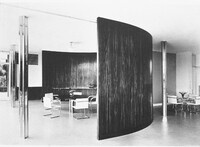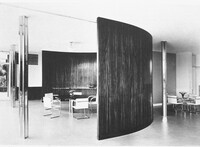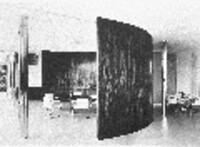| dc.coverage.spatial | Site: Brno, Jihomoravský, Czech Republic | en_US |
| dc.coverage.temporal | 1928-1930 (creation) | en_US |
| dc.creator | Mies van der Rohe, Ludwig | en_US |
| dc.date | 1928-1930 | en_US |
| dc.date.accessioned | 2013-05-07T19:28:02Z | |
| dc.date.available | 2013-05-07T19:28:02Z | |
| dc.date.issued | 1928-1930 | en_US |
| dc.identifier | 214431 | en_US |
| dc.identifier.other | archrefid: 183 | en_US |
| dc.identifier.uri | http://hdl.handle.net/1721.3/121798 | |
| dc.description | View of the curved dining room wall; The Tugendhat House (1928-1930; badly damaged by war but now refurbished), Brno, Czech Republic, interprets the ideas of the German Pavilion in a domestic context. These two buildings and the furniture that he designed for them established him as an architect and furniture designer of international stature. In 1930, at the recommendation of Walter Gropius, Mies van der Rohe was appointed Director of the Bauhaus. Villa Tugendhat was designated a World Heritage Site by UNESCO in 2001. Source: Grove Art Online; http://www.groveart.com/ (accessed 12/2/2007) | en_US |
| dc.rights | © Scott Gilchrist, Archivision, Inc. | en_US |
| dc.subject | architectural exteriors | en_US |
| dc.subject | commercial and industrial design | en_US |
| dc.subject | Modernist | en_US |
| dc.subject | Bauhaus | en_US |
| dc.title | Tugendhat House | en_US |
| dc.title.alternative | Villa Tugendhat | en_US |
| dc.type | image | en_US |
| dc.rights.access | Licensed for educational and research use by the MIT community only | en_US |
| dc.identifier.vendorcode | 1A1-MVR-TH-A1 | en_US |
| vra.culturalContext | German | en_US |
| vra.technique | construction (assembling) | en_US |
| vra.worktype | house | en_US |
| dc.contributor.display | Ludwig Mies van der Rohe (German architect, 1886-1969) | en_US |



